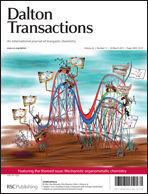C–N coupling in the gas-phase reactions of ammonia and [M(CH)]+ (M = Ni, Pd, Pt): a combined experimental/computational exercise
Abstract
Electrospray ionization (ESI) of methanolic solutions of monomeric nickel(II) acetate, [Ni(CH3COO)2], and tetrameric platinum(II) acetate, [Pt4(CH3COO)8], leads to the formation of the corresponding methylidyne complexes [M(CH)]+ (M = Ni, Pt), which react with ammonia under C–N coupling. While the product couples M/[CH4N]+ and [M(CH2N)]+/H2 are observed for both metals, hydrogen-atom expulsion to generate [M(CHNH2)]+/H is only observed in the case of the nickel-containing system, and the proton transfer leading to M/[NH4]+ is limited to platinum. Attempts to conduct related experiments with [Pd(CH)]+/NH3 failed. The mechanisms that explain the experimentally observed reaction channels have been investigated computationally using the B3LYP functional for all metals of the nickel group (M = Ni, Pd, Pt). In line with labeling experiments using the reaction pairs [M(CD)]+/NH3 and [M(CH)]+/ND3 (M = Ni, Pt), two different mechanistic scenarios of the dehydrogenation process are operative for the Ni and Pt systems, respectively.
![Graphical abstract: C–N coupling in the gas-phase reactions of ammonia and [M(CH)]+ (M = Ni, Pd, Pt): a combined experimental/computational exercise](/en/Image/Get?imageInfo.ImageType=GA&imageInfo.ImageIdentifier.ManuscriptID=C3DT32596B&imageInfo.ImageIdentifier.Year=2013)
- This article is part of the themed collection: Mechanistic Organometallic Chemistry

 Please wait while we load your content...
Please wait while we load your content...